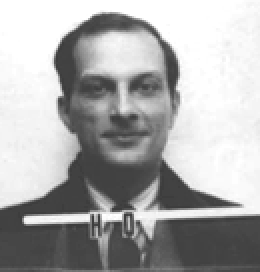Source: Adventures of a Mathematician - Third Edition (1991), Chapter 3, Travels Abroad, p. 52
Famous Stanislaw Ulam Quotes
“It is not so much whether a theorem is useful that matters, but how elegant it is.”
Source: Adventures of a Mathematician - Third Edition (1991), Chapter 15, Random Reflections on Mathematics and Science, p. 274
“In mathematics, as in physics, so much depends on chance, on a propitious moment.”
Source: Adventures of a Mathematician - Third Edition (1991), Chapter 5, Harvard Years, p. 95
as quoted by Olgierd Budrewicz in The melting-pot revisited: twenty well-known Americans of Polish background http://books.google.com/books?ei=jntPUNaTMafZ0QHMloGQBQ&id=pc51AAAAMAAJ&dq=Olgierd+Budrewicz%7C&q=Sometimes+I+muse#search_anchor, publish by Interpress, page 36, 1977.
“Thoughts are steered in different ways.”
Source: Adventures of a Mathematician - Third Edition (1991), Chapter 15, Random Reflections on Mathematics and Science, p. 275
Source: Adventures of a Mathematician - Third Edition (1991), Chapter 15, Random Reflections on Mathematics and Science, p. 274
Stanislaw Ulam Quotes about mathematics
Source: Adventures of a Mathematician - Third Edition (1991), Chapter 4, Princeton Days, p. 76
In Heinz R. Pagels, The Dreams of Reason: The Computer and the Rise of the Sciences of Complexity, Ch. 3, p. 94; as quoted in Gaither's Dictionary of Scientific Quotations (Springer, 2008), p. 861
Source: Adventures of a Mathematician - Third Edition (1991), Chapter 15, Random Reflections on Mathematics and Science, p. 277
Source: Adventures of a Mathematician - Third Edition (1991), Chapter 7, The University of Wisconsin, p. 125
Source: Adventures of a Mathematician - Third Edition (1991), Chapter 2, Student Years, p. 37
Source: Adventures of a Mathematician - Third Edition (1991), Chapter 6, Transition And Crisis, p. 120
Stanislaw Ulam Quotes about feelings
Source: Adventures of a Mathematician - Third Edition (1991), Chapter 8, Los Alamos, p. 148
“Given this optimistic nature, I feel this way even now when I am past sixty.”
Source: Adventures of a Mathematician - Third Edition (1991), Chapter 10, Back At Los Alamos, p. 208
Context: I was still very hopeful that much work lay ahead of me. Perhaps because much of what I had worked on or thought about had not yet been put into writing, I felt I still had things in reserve. Given this optimistic nature, I feel this way even now when I am past sixty.
Preface To the 1983 Edition, p. xxvii
Adventures of a Mathematician - Third Edition (1991)
Stanislaw Ulam Quotes
“For a few years I had an off-and-on romance with her.”
Source: Adventures of a Mathematician - Third Edition (1991), Chapter 2, Student Years, p. 45 (On Ada Halpern...)
Context: Ada came from Lwów. She was a very good looking girl who was studying mathematics at the University of Geneva. For a few years I had an off-and-on romance with her.
Source: Adventures of a Mathematician - Third Edition (1991), Chapter 2, Student Years, p. 34
Context: Thinking very hard about the same problem for several hours can produce a severe fatigue, close to a breakdown. I never really experienced a breakdown, but have felt "strange inside" two or three times during my life.
Source: Adventures of a Mathematician - Third Edition (1991), Chapter 6, Transition And Crisis, p. 119
Context: There may be such a thing as habitual luck. People who are said to be lucky at cards probably have certain hidden talents for those games in which skill plays a role. It is like hidden parameters in physics, this ability that does not surface and that I like to call "habitual luck".
On the Ergodic Behavior of Dynamical Systems (LA-2055, May 10, 1955) in [Stanisław Marcin Ulam, Analogies between Analogies, The Mathematical Reports of S.M. Ulam and His Los Alamos Collaborators, University of California Press, 1990, http://ark.cdlib.org/ark:/13030/ft9g50091s/]
“According to recent studies, at least one star out of three is multiple.”
Source: Adventures of a Mathematician - Third Edition (1991), Chapter 13, Government Science, p. 258
Source: Adventures of a Mathematician - Third Edition (1991), Chapter 3, Travels Abroad, p. 55
“Whatever is worth saying, can be stated in fifty words or less.”
as quoted by Gian-Carlo Rota in Words spoken at the memorial service for S. M. Ulam (The Lodge, Los Alamos, New Mexico, May 17, 1984), published in The Mathematical Intelligencer, Volume 6, Number 4 / December, 1984
Attributed in Paul Hoffman, The Man Who Loved Only Numbers: The Story of Paul Erdős and the Search for Mathematical Truth (1998)
This has also been attributed, with variants, to Paul Erdős, who repeated the remark.
Source: Adventures of a Mathematician - Third Edition (1991), Chapter 14, Professor Again, p. 267
Source: Adventures of a Mathematician - Third Edition (1991), Chapter 5, Harvard Years, p. 96
Prologue, p. 5
Adventures of a Mathematician - Third Edition (1991)
Source: Adventures of a Mathematician - Third Edition (1991), Chapter 5, Harvard Years, p. 91
Source: Adventures of a Mathematician - Third Edition (1991), Chapter 15, Random Reflections on Mathematics and Science, p. 278
Source: Adventures of a Mathematician - Third Edition (1991), Chapter 1, Childhood, p. 12
“I am turned off when I see only formulas and symbols, and little text.”
Source: Adventures of a Mathematician - Third Edition (1991), Chapter 15, Random Reflections on Mathematics and Science, p. 275
Source: Adventures of a Mathematician - Third Edition (1991), Chapter 15, Random Reflections on Mathematics and Science, p. 273-274
Source: Adventures of a Mathematician - Third Edition (1991), Chapter 11, The 'Super', p. 222
Source: Adventures of a Mathematician - Third Edition (1991), Chapter 8, Los Alamos, p. 169
